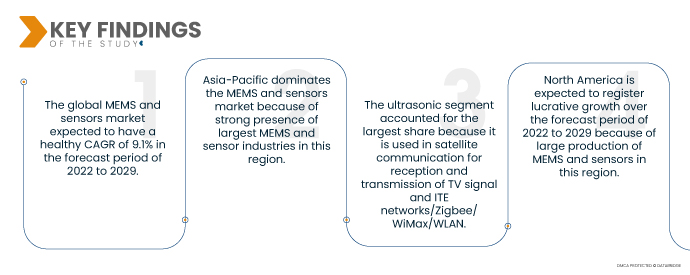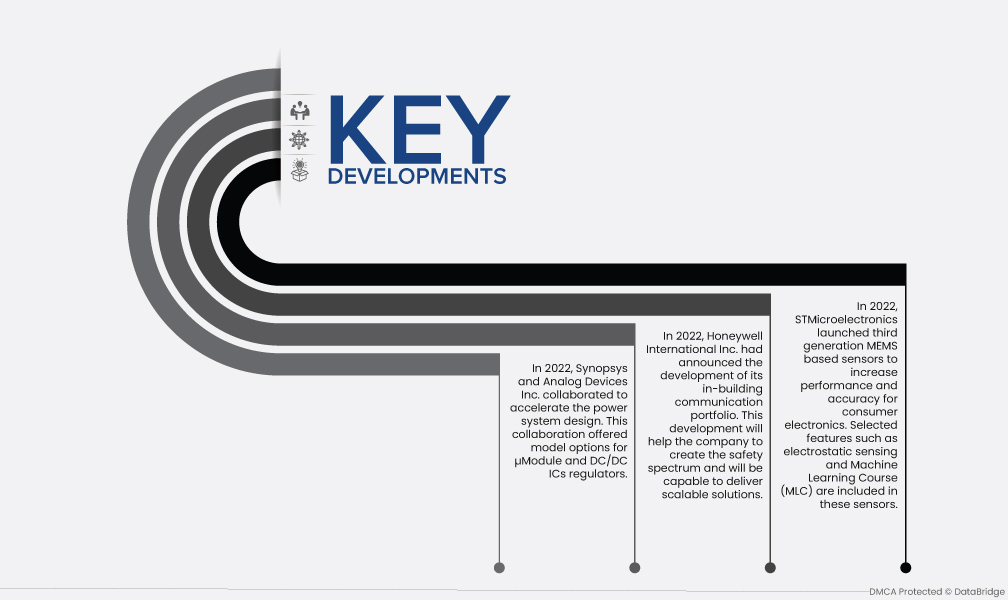The world has progressively shifted its preference from conventional to electric vehicles. MEMS and sensor-based devices are important parts of electronic control systems in vehicles. The Sensors are used for security purposes in vehicles because they can be operated in rough and harsh conditions involving extreme vibrations, temperatures, and exposure to environmental contaminants. Therefore, increasing demand for MEMS and sensors for security is likely to enhance the market growth in upcoming years.
Access Full Report @ https://www.databridgemarketresearch.com/reports/global-mems-and-sensors-market
Data Bridge Market Research analyses that a growth rate in the Global MEMS and Sensors Market is expected to have a healthy CAGR of 9.1% from 2022 to 2029. Rising demand for smart grid infrastructure will likely increase the growth of the global MEMS and sensors market.
Key Findings of the Study:
- The global MEMS and sensors market is expected to have a healthy CAGR of 9.1% from 2022 to 2029.
- Asia-Pacific dominates the MEMS and sensors market because of the strong presence of this region's largest MEMS and sensor industries.
- The ultrasonic segment accounted for the largest share because it is used in satellite communication to receive and transmit TV signals and ITE networks/Zigbee/ WiMax/WLAN.
- North America is expected to register lucrative growth over the forecast period of 2022 to 2029 because of the large production of MEMS and sensors in this region.
Government initiatives to reduce emission levels are expected to drive the market's growth rate
Consumers are shifting their preferences towards more sophisticated technologies and are highly adopting consumer electronics that gestures and touch can control. MEMS and sensors in consumer electronics and household appliances include temperature, flow and level, pressure, proximity, motion, acoustic, touch, and image sensors. Furthermore, sensors have drastically changed because their sizes have reduced while their efficiency has augmented multiple folds. As a result, increasing demand for consumer electronics is expected to drive the market's growth.
Report Scope and Market Segmentation
|
Report Metric
|
Details
|
|
Forecast Period
|
2022 to 2029
|
|
Base Year
|
2021
|
|
Historic Years
|
2020 (Customizable to 2014- 2019)
|
|
Quantitative Units
|
Revenue in USD Million, Volumes in Units, Pricing in USD
|
|
Segments Covered
|
Type (Inertial Sensor, Ultrasonic Sensor, Position Sensor, Motion Sensor, Microphone, Bio/Chemical Sensor, Optical Sensor, and Environmental Sensors), Material (Polymer, Metal, Silicon, and Ceramic), Packaging Size (Less Than 0.5 MM, 0.5 MM To 0.9 MM, More Than 0.9 MM), Fabrication Process (Deposition, Lithography, and Etching), Actuator Type (Optical, RF, Microfluidics and Inkjet Head), End User (Consumer Electronics, IT and Telecommunication, Automotive, Aerospace, Defense, Medical, Industrial and Manufacturing, Smart Grid Infrastructure, Smart Homes, Gaming and Others)
|
|
Countries Covered
|
U.S., Canada and Mexico in North America, Germany, France, U.K., Netherlands, Switzerland, Belgium, Russia, Italy, Spain, Turkey, Rest of Europe in Europe, China, Japan, India, South Korea, Singapore, Malaysia, Australia, Thailand, Indonesia, Philippines, Rest of Asia-Pacific (APAC) in the Asia-Pacific (APAC), Saudi Arabia, U.A.E, South Africa, Egypt, Israel, Rest of Middle East and Africa (MEA) as a part of Middle East and Africa (MEA), Brazil, Argentina and Rest of South America as part of South America
|
|
Market Players Covered
|
Texas Instruments Incorporated (U.S.), Panasonic Corporation (Japan), Siemens (Germany), Honeywell International Inc. (U.S.), ABB (Switzerland), Analog Devices, Inc. (U.S.), General Electric Company (U.S.), Kongsberg (Norway), Emerson Electric Co. (U.S.), STMicroelectronics (Switzerland), Microchip Technology Inc. (U.S.), NXP Semiconductors (Netherland), Maxim Integrated (U.S.) and Mouser Electronics, Inc. (U.S.), Robert Bosch GmbH (Germany), TE Connectivity (Switzerland), OMEGA Engineering Inc. (U.S.), Semiconductor Components Industries, LLC (U.S.), Endress+Hauser Hauser Group Services AG (Switzerland), Amphenol Corporation (U.S.) among others
|
|
Data Points Covered in the Report
|
In addition to the insights on market scenarios such as market value, growth rate, segmentation, geographical coverage, and major players, the market reports curated by the Data Bridge Market Research also include in-depth expert analysis, geographically represented company-wise production and capacity, network layouts of distributors and partners, detailed and updated price trend analysis and deficit analysis of supply chain and demand
|
Segment Analysis:
The MEMS and sensors market is segmented on the basis of type, material, packaging size, fabrication process, actuator type, and end user.
- Based on type, the global MEMS and sensors market is segmented into inertial sensor, ultrasonic sensor, position sensor, motion sensor, microphone, bio/chemical sensor, optical sensor, and environmental sensor. The ultrasonic segment is expected to dominate the global MEMS and sensors market with a 31.39% market share because it is used in satellite communication for reception and transmission of TV signal, radio reception and transmission, and ITE networks/Zigbee/ WiMax/WLAN.
- Based on material, the global MEMS and sensors market is segmented into polymer, metal, silicon and ceramic. The polymer segment is expected to dominate the global MEMS and sensors market with 31.39% market share because it is used in numerous satellite, radar and terrestrial communications applications. Moreover, it has low bandwidth because of its low-frequency range which is making it more appropriate for streaming applications such as voice, video and broadband connectivity.
- Based on the packaging size, the global MEMS and sensors market is segmented less than 0.5 mm, 0.5 mm to 0.9 mm, and more than 0.9 mm.
The less than 0.5MM segment of packaging size segment is anticipated to dominate the MEMS and sensors market
Less than 0.5MM segment is expected to dominate the global MEMS and sensors market with 31.39% market share because of increasing demand for high-speed internet connectivity. Furthermore, the increasing need for managed and data center collocation services is raising the demand for the MEMS and sensors in the market.
- Based on fabrication process, the global MEMS and sensors market is segmented into deposition, lithography and etching. The deposition segment is expected to dominate the global MEMS and sensors market with 31.39% market share because it is mostly used for 4G, 5G, and LIT connections. This frequency is also used for regular communication and navigation.
- Based on actuator type, the global MEMS and sensors market is segmented into optical, RF, microfluidics and inkjet head. RF is further segmented into switch, filter and oscillator. The optical segment is expected to dominate the global MEMS and sensors market with 31.39% market share because they can offer reliable and secure connectivity, high speed for satellite communication, television broadcast and military application.
- Based on end user, the global MEMS and sensors market has been segmented into consumer electronics, IT and telecommunication, automotive, aerospace, defense, medical, industrial and manufacturing, smart grid infrastructure, smart homes, gaming, and others.
The consumer electronics segment of end user segment is anticipated to dominate the weara MEMS and sensors market
The consumer electronics segment is expected to dominate the global MEMS and sensors market with 31.39% market share because of increasing demand for stable and faster speed connectivity. Furthermore, advancements in the 5G network and wireless solution increase the demand for MEMS and sensors in the telecom industry.
Major Players
Data Bridge Market Research recognizes the following companies as the major MEMS and sensors market players in MEMS and sensors market Texas Instruments Incorporated (U.S.), Panasonic Corporation (Japan), Siemens (Germany), Honeywell International Inc. (U.S.), ABB (Switzerland), Analog Devices, Inc. (U.S.), General Electric Company (U.S.), Kongsberg (Norway), Emerson Electric Co. (U.S.), STMicroelectronics (Switzerland), Microchip Technology Inc. (U.S.), NXP Semiconductors (Netherland), Maxim Integrated (U.S.) and Mouser Electronics, Inc. (U.S.)
Market Development
- In 2022, Synopsys and Analog Devices Inc. collaborated to accelerate the power system design. This collaboration offered model options for µModule and DC/DC ICs regulators. The collaboration will also help to develop electronic system innovation and fulfill customers' design targets. Moreover, this collaboration will support the companies in raising their customer base.
- In 2022, Honeywell International Inc. announced the development of its in-building communication portfolio. This development will help the company to create the safety spectrum and will be capable of delivering scalable solutions. This will also help the company to target new clients.
- In 2022, STMicroelectronics launched third-generation MEMS-based sensors to increase performance and accuracy for consumer electronics. Selected features such as electrostatic sensing and Machine Learning Courses (MLC) are included in these sensors. This product launch will aid the company in improving MEMS sensors with the QVAR user interface to ensure seamless interactions.
Regional Analysis
Geographically, the countries covered in the MEMS and sensors market report are U.S., Canada and Mexico in North America, Germany, France, U.K., Netherlands, Switzerland, Belgium, Russia, Italy, Spain, Turkey, Rest of Europe in Europe, China, Japan, India, South Korea, Singapore, Malaysia, Australia, Thailand, Indonesia, Philippines, Rest of Asia-Pacific (APAC) in the Asia-Pacific (APAC), Saudi Arabia, U.A.E, South Africa, Egypt, Israel, Rest of Middle East and Africa (MEA) as a part of Middle East and Africa (MEA), Brazil, Argentina and Rest of South America as part of South America.
As per Data Bridge Market Research analysis:
Asia-Pacific is the dominant region in MEMS and sensors market during the forecast period 2022 to 2029
Asia-Pacific dominates the MEMS and sensors market due to the strong presence of this region's largest MEMS and sensor industries. Furthermore, MEMS and sensor industries produce cheaper products in this region, further boosting the market growth.
North America is estimated to be the fastest growing region in MEMS and sensors market for the forecast period 2022 to 2029
North America is expected to grow from 2022 to 2029 because of the large production of MEMS and sensors in this region. Additionally, increasing consumer demand for MEMS and sensors will further boost market growth.
For more detailed information about MEMS and sensors market report, click here – https://www.databridgemarketresearch.com/reports/global-mems-and-sensors-market












